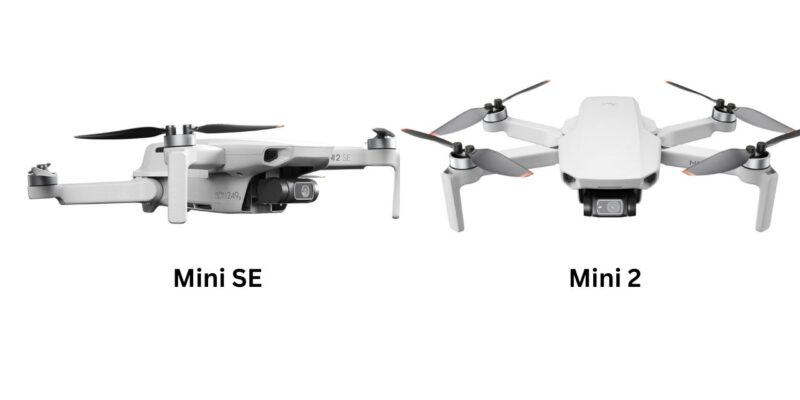In 2024, DJI continues to dominate the market with compact, consumer-friendly drones. Two popular models in their lineup are the DJI Mini 2 and the DJI Mini SE. Both are lightweight, easy to use, and great for beginners, but they do have notable differences that set them apart. Let’s dive into the key aspects to consider in this comparison.
1. Camera Quality
- DJI Mini 2:
- 12MP camera with 1/2.3” CMOS sensor.
- 4K video recording at 30fps.
- 3-axis gimbal for smooth, stabilized footage.
- 100 Mbps max video bitrate.
- DJI Mini SE:
- 12MP camera with 1/2.3” CMOS sensor.
- 2.7K video recording at 30fps.
- 3-axis gimbal for stability.
- 40 Mbps max video bitrate.
Verdict: The Mini 2 has a significant edge with its ability to shoot in 4K, offering higher resolution and a better bitrate for more detailed footage.
2. Transmission Range and Technology
- DJI Mini 2:
- OcuSync 2.0 transmission system.
- Up to 10 km (6.2 miles) range (FCC).
- DJI Mini SE:
- Enhanced Wi-Fi.
- Up to 4 km (2.5 miles) range (FCC).
Verdict: The Mini 2 outperforms with its OcuSync 2.0 transmission, offering a more reliable connection over a greater distance.
3. Flight Time
- DJI Mini 2: Up to 31 minutes of flight time.
- DJI Mini SE: Up to 30 minutes of flight time.
Verdict: Both drones offer nearly identical flight times, with the Mini 2 having a slight edge at 31 minutes.
4. Weight
- DJI Mini 2: 249g.
- DJI Mini SE: 249g.
Both drones fall under the 250g limit, meaning you don’t need to register them in most regions, making them highly portable and regulation-friendly.
5. Wind Resistance
- DJI Mini 2: Level 5 wind resistance (up to 29-38 km/h or 17-23 mph).
- DJI Mini SE: Level 5 wind resistance (up to 29-38 km/h or 17-23 mph).
Verdict: Both drones are equally adept at handling moderate winds, making them versatile for different weather conditions.
6. Intelligent Flight Features
- DJI Mini 2:
- Includes QuickShots (Dronie, Rocket, Circle, Helix, Boomerang).
- Panorama modes.
- Raw photo capabilities.
- DJI Mini SE:
- Also includes QuickShots (Dronie, Rocket, Circle, Helix).
- Lacks panorama and RAW photo capabilities.
Verdict: The Mini 2 is more versatile with additional panorama modes and RAW format support, making it ideal for photographers and videographers who want more control over their content.
7. Pricing
- DJI Mini 2: Typically priced higher due to its advanced features, hovering around $449 for the standard package.
- DJI Mini SE: A more budget-friendly option, usually priced around $299.
Verdict: The Mini SE wins on affordability, making it a great choice for those who want a solid drone without breaking the bank.
8. Ideal Use Cases
- DJI Mini 2:
- Perfect for hobbyists and semi-professionals who need 4K video and long-range transmission.
- Suitable for those who want to travel with a lightweight drone but also want professional-level output.
- DJI Mini SE:
- Aimed at beginners who want a cost-effective drone with solid features.
- Ideal for casual users looking for good video quality without the need for 4K or extended range.
Conclusion: Which Drone to Choose?
- Choose the DJI Mini 2 if you’re looking for better camera quality, longer range, and advanced features like RAW photo and panorama modes.
- Opt for the DJI Mini SE if you’re a beginner or on a budget but still want an excellent drone experience.
Both models offer exceptional value, but the Mini 2 is the clear choice if you want the best performance. The Mini SE is a great affordable alternative for those not needing the highest specs.
DJI Mini 2 vs. Mini SE: The Ultimate Comparison for 2024
Drones have become increasingly popular in recent years, with DJI at the forefront of this technological evolution. As 2024 unfolds, two of DJI’s most sought-after models, the DJI Mini 2 and DJI Mini SE, continue to captivate the consumer market. Both drones cater to a similar audience—those looking for a lightweight, easy-to-fly, yet high-quality drone. However, the two models differ in terms of features, camera performance, and price, which makes choosing between them a bit of a challenge. This comprehensive comparison will help you decide which drone is better suited to your needs in 2024.
1. Design and Build
Both the DJI Mini 2 and Mini SE are ultra-lightweight drones weighing just 249 grams, a key factor for many drone enthusiasts. This weight class exempts them from registration in many countries, including the U.S., which imposes mandatory registration for drones weighing over 250 grams. Additionally, their compact size makes them easy to carry, perfect for travel and on-the-go flying.
The design language of both drones is very similar. They are equipped with foldable arms, which further enhances portability. DJI’s choice of materials in both models is lightweight yet durable, ensuring these drones can withstand regular use and minor impacts. Despite the similarity in size and weight, the internals is where the differences begin to show.
2. Camera Performance
When it comes to camera capabilities, the DJI Mini 2 is undoubtedly superior, especially in terms of video quality. The Mini 2 features a 12MP camera with a 1/2.3-inch CMOS sensor, capable of recording in 4K resolution at 30 frames per second (fps). This gives you crisp, clear footage with rich details, especially when viewed on larger screens or for professional use. Moreover, the Mini 2 records at a 100 Mbps bitrate, allowing for more data per second of video, resulting in higher-quality output, especially in complex scenes.
On the other hand, the DJI Mini SE also has a 12MP camera with the same 1/2.3-inch sensor, but it is limited to 2.7K resolution at 30fps. While 2.7K video is still respectable for casual use and hobbyist videography, it lacks the sharpness and clarity that 4K provides. Additionally, the Mini SE’s 40 Mbps bitrate means that it captures less data compared to the Mini 2, potentially leading to less detail in the footage, especially in fast-moving scenes or areas with a lot of visual complexity (such as foliage or water).
Both drones feature 3-axis mechanical gimbals, ensuring smooth and stable footage even in moderately windy conditions or when performing fast maneuvers. However, for those who prioritize camera quality and intend to use their drone for more professional or creative purposes, the Mini 2’s 4K recording capability makes it the clear winner in this category.
3. Transmission Range and Technology
One of the most significant differences between the Mini 2 and Mini SE is the transmission technology. The DJI Mini 2 uses DJI’s OcuSync 2.0, which offers an impressive 10 km (6.2 miles) range (in FCC-compliant regions). This advanced transmission technology not only allows for longer flight distances but also ensures a more stable connection, reducing the likelihood of signal loss, even in areas with wireless interference.
In contrast, the Mini SE uses enhanced Wi-Fi for its transmission, with a maximum range of 4 km (2.5 miles). While this is still a reasonable range for most casual flights, it’s significantly less than the Mini 2’s. Additionally, enhanced Wi-Fi is more prone to interference, especially in urban environments with many competing wireless signals.
For pilots who plan to fly their drone over long distances or those who require a more robust and stable connection for real-time video streaming, the DJI Mini 2’s OcuSync 2.0 is a substantial advantage.
4. Flight Time and Battery Life
Flight time is crucial when choosing a drone, and both the Mini 2 and Mini SE deliver excellent performance in this regard. The DJI Mini 2 boasts a maximum flight time of 31 minutes, while the Mini SE offers up to 30 minutes. While the difference of one minute may seem negligible, in practice, this slight advantage can provide just enough extra flight time for a perfect shot or safe return when the battery is low.
Both drones use intelligent flight batteries that help manage power consumption efficiently, and they feature warnings when battery levels are low. Battery life, while excellent for both models, will vary depending on flight conditions, such as wind and flight speed.
5. Wind Resistance
Despite their small size, both drones are capable of handling moderate wind conditions. They are both rated for Level 5 wind resistance, meaning they can withstand wind speeds of 29-38 km/h (17-23 mph). This capability makes them suitable for outdoor flights even in less-than-ideal weather, but pilots should always exercise caution in high winds or turbulent conditions, particularly due to the lightweight nature of these drones.
6. Intelligent Flight Features
One of DJI’s strong points is its suite of intelligent flight features, and both the Mini 2 and Mini SE come with a variety of useful modes.
- DJI Mini 2: The Mini 2 includes QuickShots modes like Dronie, Rocket, Circle, Helix, and Boomerang. These pre-programmed flight paths make it easy to capture professional-looking video with minimal effort. Additionally, the Mini 2 supports Panorama modes (Sphere, 180°, and Wide-Angle) for capturing wide-angle shots, as well as RAW photo capabilities, which provide more flexibility in post-production. These advanced features make the Mini 2 more appealing for serious photographers and videographers.
- DJI Mini SE: The Mini SE also includes several QuickShots modes, such as Dronie, Rocket, Circle, and Helix. However, it lacks Boomerang mode, and does not offer Panorama or RAW support. While the SE’s QuickShots are excellent for casual users and beginners, they do not provide the same creative freedom as the Mini 2’s more advanced options.
7. Pricing
The DJI Mini 2 is the more premium model, priced around $449 for the base package. This is a reflection of its superior camera, transmission technology, and extra features. For many users, the extra cost is justified by the additional capabilities the Mini 2 offers.
The DJI Mini SE, on the other hand, is a budget-friendly option, typically priced around $299. For users who do not need 4K video or the extended range provided by OcuSync 2.0, the Mini SE is an excellent value.
8. Ideal Use Cases
- DJI Mini 2: Ideal for semi-professionals, hobbyists, and travelers who want the best video quality, extended range, and more advanced features. Its 4K video capability and OcuSync 2.0 transmission make it suitable for more demanding projects, including YouTube content, social media videos, and even entry-level professional work.
- DJI Mini SE: Best suited for beginners and casual users looking for an affordable, easy-to-use drone with solid video quality. The 2.7K resolution is more than sufficient for social media and personal projects, and its lower price makes it more accessible to first-time drone users.
Conclusion: Which Drone Should You Choose?
The DJI Mini 2 and Mini SE are both exceptional drones, but they cater to slightly different audiences.
- If you’re looking for top-tier performance, including 4K video, long-range transmission, and additional creative modes, the DJI Mini 2 is the best choice for you. It offers a significant upgrade over the Mini SE, making it more suitable for professionals and enthusiasts who want to capture the highest-quality footage.
- If you’re a beginner or on a budget, the DJI Mini SE provides incredible value. While it lacks some of the more advanced features of the Mini 2, it still delivers excellent performance, making it perfect for casual flying and personal content creation.












